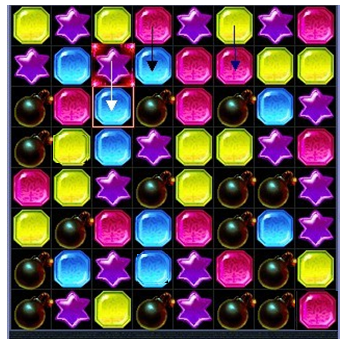
| Online Judge | Online Exercise | Online Teaching | Online Contests | Exercise Author |
|
F.A.Q Hand In Hand Online Acmers |
Best Coder beta VIP | STD Contests DIY | Web-DIY beta |
DUIDUI Bang
Time Limit: 18000/9000 MS (Java/Others) Memory Limit: 65536/65536 K (Java/Others)Total Submission(s): 189 Accepted Submission(s): 92
Problem Description
You are given an 8 by 8 chessboard and five different kinds of pawn. The rule is simple; you can only swap two adjacent pawns. After the swap, if there are three or more consecutive identical pieces either horizontally or vertically, they will be eliminated. After that, the pawn will fall down to fill the empty grids. The empty grids that no pawn fills will be filled by randomly picked pawn from top edge. Sometimes you may be lucky enough to have the pawn eliminated automatically according to the rules above. In addition, if there is one move leads to eight or more than eight pawn to be eliminated, the player will be granted a combo. A smart guy as you are, could you please tell us what is the maximum possibility to trigger a combo in one swap?

In the figure, for example, swap the blue gem and the purple star will ensure a combo. Because, this will cause the red gem fall down and eliminated. The yellow gems will disappear after the red ones.

In the figure, for example, swap the blue gem and the purple star will ensure a combo. Because, this will cause the red gem fall down and eliminated. The yellow gems will disappear after the red ones.
Input
The first line contains a single integer t, the number of test cases.
For each case, 8 lines contain pawn data. See sample input for more details.
For each case, 8 lines contain pawn data. See sample input for more details.
Output
For each case, output maximum possibility of combo. See sample output for more details.
Sample Input
2 10112344 13213241 30404021 31104204 23221011 02041200 14102122 22330443 13143243 42422004 11012130 34400104 03142423 21220441 01021133 43044200
Sample Output
Case #1: 1.000 Case #2: 0.525
Author
BJTU
Source
| Home | Top |
Hangzhou Dianzi University Online Judge 3.0 Copyright © 2005-2024 HDU ACM Team. All Rights Reserved. Designer & Developer : Wang Rongtao LinLe GaoJie GanLu Total 0.000000(s) query 1, Server time : 2024-11-22 10:05:35, Gzip enabled |
Administration |